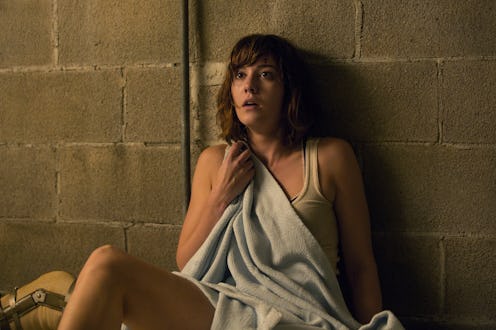
For a movie that doesn't even pass the Bechdel test, 10 Cloverfield Lane is pretty feminist. Yes, the film only features one female character, Michelle (Mary Elizabeth Winstead), who, clad in no more than underwear and a white tank top at times, spends a majority of the film alone with two men, but she's not your standard Hollywood heroine. Michelle stands apart, due to one crucial aspect: she isn't portrayed as a sexual object, and when the possibility is presented, she refuses to become one.
Some spoilers ahead: Unlike many thrillers and horror movies, 10 Cloverfield Lane almost immediately takes sex out of the equation, letting its plot instead be propelled by Michelle's will and ability to survive, neither of which are dependent on her sexual appeal to men. Early in the film, Michelle wakes up in an empty cell, chained to the wall, wearing nothing but her underwear and a white tank top. Her jeans are neatly folded in the corner, just out of reach, and she has a knee brace locked onto her leg. It's a terrifying image, made even more unbearable when her captor, Howard (John Goodman), walks in. Goodman is an intimidating presence who is clearly in a position of power, and any female viewer can see that Michelle could be in grave danger. Women are taught from an early age to fear rape and to avoid situations where the threat of sexual violence might present itself. For a minute, it looks like 10 Cloverfield Lane might be scarily similar to Room.
The threat of sexual violence in that moment is palpable, and yet, surprisingly, it's quickly taken out of the equation. Howard leaves Michelle to put her jeans back on, and she's never unclothed again. Furthermore, the power dynamic between the two never feels fueled by any kind of sexual desire, and any lingering threat is taken away when (spoiler alert) it is revealed that Howard sees Michelle as a sort of replacement for the daughter he lost. If anything, Howard is adamant that Michelle not be a sexual being. When he introduces her to Emmett, the young man who has also taken refuge in the bunker, Howard tells Emmett explicitly that he is not to touch Michelle in any way.
And this is where things get even more interesting. Despite the fact that Emmett and Michelle are about the same age and stuck in a bunker together, there is no romantic storyline in the movie — not even a genuine flirtation. As the film goes on, the duo develop a friendship, but never more. Michelle isn't special to Emmett or to Howard because of her sexuality, and it's not a factor for the audience, either. 10 Cloverfield Lane doesn't court viewer by flaunting a half-naked female lead (or male lead, for that matter). Instead, Michelle's appeal lies in her strength, her cleverness, and her general awesomeness as a character.
It's not that she ignores her sexuality completely; Michelle does use her sexual appeal to her advantage when she's testing the boundaries with Howard and trying to escape. But it just goes to show that unlike so many female characters in film, Michelle is only sexy when she wants to be — not when men want her to be, and not when the audience wants her to be. 10 Cloverfield Lane is far more than just a movie about a sexy girl running from monsters, and in Hollywood, that's pretty revolutionary.
If the movie featured a male protagonist, none of this would be as exciting — plenty of films star male leads without making their sexualities major parts of their stories. But it's highly unusual to see a female character on-screen who's put in both positions of weakness and strength without being sexualized; Winstead herself admitted to Bustle recently that finding a role like Michelle is all too rare. "The thing that's so great about this is that she's this quote-unquote 'badass character,' but she's also very real. And the thing that I find is that it's usually one or the other," said the star.
10 Cloverfield Lane's decision to feature a fully-formed female lead — and not use her as a sexual prop or make her sexuality her most defining trait — is a welcome change from the movie norm, and here's hoping plenty of other films take note.
Images: Paramount Pictures